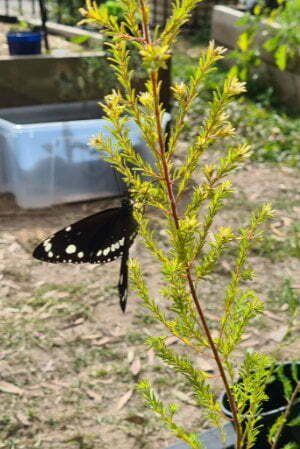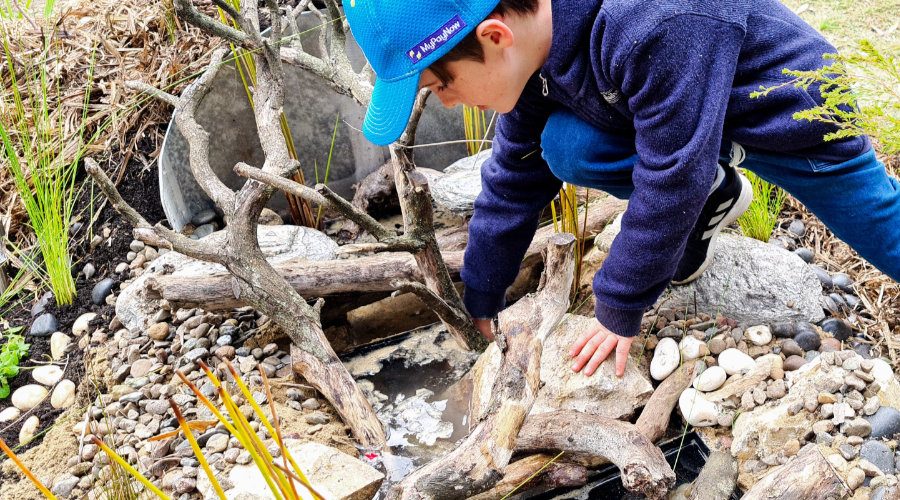School builds frog—insect—butterfly habitat with students
Story and photos by Rosemary Charles, July 2022
How it got started
Patricia Dwyer at Currumbin Community Special School has been working hard over the past year to progress the school’s sustainability initiatives. She has had the whole school focused on rejuvenating the kitchen garden which was originally established under the Stephanie Alexander program.
The first step — retrofit existing garden beds with wicking beds
Aqualess has been working side by side with the school during this journey. The first step was to retrofit the existing garden beds with the WaterUps wicking system so that the gardens became manageable for the teachers and students. No more daily watering. No more plants wilting over weekends and dying during school holidays if teachers can’t come in and water the gardens.

Tasty gardens
As important is the taste, quality and volume of produce the gardens are now producing for the students to use in their hospitality studies, food preparation for the canteen and catering for school special events.
Quiet place
Additionally, the garden now acts as a quiet place for students when they are agitated or need to refocus. They can walk around, pick and eat food and weed — all to help them focus and feel calm.
Indigenous garden
The school has an existing indigenous garden which they decided they wanted to integrate more into the general garden activities of the school. The school has been working for some months now on establishing a Yarning Circle with input from their local Aunty.
Worm farms
Aqualess built and installed two hardwood timber worm gardens which are on castors and can be moved around as part of this project. These worm farms double as seats for outdoor sessions and have combination locks on them to control access. Two matching timber wicking planters were commissioned to stand next to the hills hoist Yarning Circle shade frame for vines to provide shade in Summer.
The planters were built and fitted by Aqualess, who donated the vines and are now in the process of donating a Bird Wing Vine for this area to assist the school in contributing to efforts to reintroduce the rare Bird Wing Butterfly to this area of the Gold Coast.

The next stage — building habitats
The next stage of this integration was to start building habitats to encourage the local fauna to establish homes in the area. That’s where the combined frog, insect and butterfly came in. With the initial design by Aqualess, WaterUps has taken this project on board and is now going to manufacture a range of habitats designed for schools and early learning centres to help them introduce students to indigenous fauna.


Who was involved
Rosemary Charles from Aqualess has been working closely with Currumbin over the past year on their initiatives. Each of the projects have been funded under government grants for organic waste reduction and sustainability initiatives, with this habitat project receiving funding from the Junior Landcare grants. Rosemary saw this project as the perfect opportunity to start establishing closer relationships between the school and local community groups directly involved in food production and environmental sustainability.
Lyn Mansfield from Community Gardens Australia (Queensland) and Sue Durance from Landcare were both invited to become involved with the school through this project. Aqualess hopes that this will be the first of many schools that will start working with both these community groups across the rejuvenation of existing, or establishment of new edible gardens and a move towards establishing specially designed indigenous habitats and bush tucker gardens built around experiential learning activities for children of all ages.
As a proof of concept for this to be rolled out into all interested schools and early learning centres, the project has been a great success so far. Both Lyn and Sue were very involved in the planning and execution of the installation.
Lyn’s connections with local frog experts, her enthusiasm, practical skills, experience and boundless energy contributed significantly to the project. Sue’s great depth of knowledge on appropriate indigenous plants for frogs, insects and butterflies and her connections for organising access to suitable species of plants leading up to the installation was of great value.
When did it start?
Then on the day — Wednesday 29 June, both Lyn and Sue worked extremely hard with the Aqualess team to build/install the habitat, plant the plants and tidy up after their work. Nothing was too much effort — lugging bags of the new Rocky Point Certified Organic soil to the site (even before it was released to the public!!), transporting sand to the installation, using these to build up the area and placing mulch around the mound all went smoothly.
Paul from Aqualess actually placed the structural framework in place. along with the driftwood and much of the sand/stones so as to ensure they were secure and safe for the children. Everyone, including Patricia’s children who were on site to ‘help’ for the morning, assisted in planting the plants and putting the finishing touches to the installation.
What else is going on?

Even before the plants were out of their pots a local butterfly came over and landed on one to see what we were up to!!! A good omen for the butterfly attracting power of the plants grown by the Queensland Butterfly Garden for the installation. These are the same species as they use in their butterfly house at Carrara markets on the Gold Coast.
WaterUps is currently in the process of finalising the commercial production of the frog and insect habitat and a reptile habitat both designed around the adaptation of their sub-irrigation system for this use. Additionally, a butterfly habitat and indigenous plant/bush tucker garden are being designed using the existing sub-irrigation system.
Of course, these installations are not just going to be suitable for the education market — they will also be great for community gardens, native habitat regeneration projects and for private residences.
Each of the pre-fabricated habitats will use the water gathering, storage and irrigating power of the WaterUps wicking system to help ensure plants have access to water over long periods of time and fauna similarly can find water to sustain them in dry periods.
More information
For those in Queensland interested in this project, they can contact:
- Rosemary Charles on 0458080861 or rosemary@aqualess.com.au.
Outside Queensland, the best person to contact at this stage for more information is:
- Eric Sturman at WaterUps on eric.sturman@waterups.com.au.
South East Queensland Community Gardens who are interested in becoming actively involved with their local schools/early learning centres, with these Aqualess wicking initiatives, contact Rosemary Charles.

